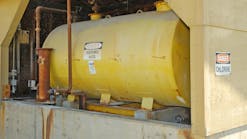by Frank Rebori
We all feel their effects. Large price spikes in basic commodities.
From carbon and stainless steel products to concrete, fuel, etc., the widespread price increases experienced in the past 18 to 24 months bring forth many negative results in the public works arena. In some cases, commodity prices have escalated 25 to 80 percent in a short time frame. Because most public infrastructure projects like treatment plants and sewer lines maintain long project life cycles (from concept to construction) ranging from 12 months to five years, the budgeting and bidding process can pose great difficulties for all parties involved: contractors, equipment suppliers, and even the end-user.
Often, short-term spikes in commodities can cause on-going projects to run over budget or contractor/manufacturers being forced to complete them at insignificant margins or on occasion even at a loss which can cause everyone involved in the project to become disgruntled. Projects also become over-budget in the bid stage because equipment manufacturer and contractor bids must anticipate what commodities may cost 24 to 36 months later.
One solution to this unpredictable, short-term volatility is to allow the use of escalation clauses. An escalation clause is a mechanism in a contract that allows for the price of the contract to be adjusted to the price of some future commodity or factor that neither buyer nor the seller can accurately predict during the contract phase. These clauses make an allowance for the most relevant commodities involved in the project such as concrete, steel or fuel, etc.
Historically, municipalities are reluctant to allow the use of these clauses because they desire fixed price, not-to-exceed contracts which provide the comfort of a set budget. While escalation clauses may result in the final cost of a project coming in at a different price then originally budgeted, escalation clauses can actually save the end user money and benefit everyone involved in the project.
When an escalation clause is utilized, the bids received may be more in line with current and reasonably expected future prices. This takes away the bidders' need to drive up their proposals to account for some future unknown variable. Contractor and manufacturers, of course, benefit because they will be reasonably covered during commodity price spikes.
Many escalation clauses are based on the Producer Price Indexes for certain commodities and products that are researched and published monthly by the U.S. Department of Labor, Bureau of Labor Statistics (BLS). The Producer Price Indexes are based on detailed research and surveys from both buyers and sellers of thousands of different commodities. Therefore it ensures as much as possible objective reports of commodity prices which can be comfortably reliable to both parties in a contract with escalation clauses. Producer Price Indexes tables can be found online at http://www.bls.gov. (The tables are also available in hard copy). The tables list the current and historical indexes for many different types of industries and products within those industries.
Other options are possible if the parties feel a different index is more relevant. For example if a project has a large amount of stainless steel, the monthly stainless steel surcharge tables for all of the various grades of stainless steel published by ATI/Allegheny Ludlum could be used. This is found online at http://www.alleghenytechnologies.com and search for "surcharges”.
The BLS also publishes online a helpful Escalation Guide that explains how the indexes are compiled and includes suggestions for incorporating them into escalation clauses.
An example of an escalation clause that could be used for a long-term project could be as follows:
The total contract price of this project being supplied by Contractor/Manufacturer is subject to a future escalation in price. Escalation shall be based upon the increase in the Producer Price Index, U.S. Department of Labor, Bureau of Labor Statistics-Group: Metals and Metal Products, Steel Mill Products, Not Seasonally Adjusted, Series Id-WPU1017 (the "Index”). The escalation shall be calculated based upon the percentage increase of the monthly Index between the date of this quotation and the date of release to manufacture of the equipment defined to be submittal approval (i.e. the Index for the month of the release to manufacture minus the Index for the month of quotation divided by the Index for the month of quotation, multiplied by the quoted price). Note there is approximately 2-4 month delay in the publishing and finalizing of these Indexes by the Bureau of Labor Statistics. Therefore, the escalation will be calculated at the time the Index for both months has been published and the final Index has been issued.
The use of an escalation clause similar to the one above could help prevent inflated bids thus helping to keep projects within designed budgets and within timelines for completion. The end user municipality has the assurance that if there is an increase in the major commodity, the increase will be based on the objective figures compiled by the Bureau of Labor Statistics. There is also the prospect that no increases in commodity prices will occur, thus there will be no price increase to the project.
When escalation clauses are utilized they preserve the integrity of the immense vendor work associated with public works projects, ensuring better workmanship and long-term value. So at the end of the day, escalation clauses can be good for everyone.
About the author:
Frank J. Rebori is Vice President and General Counsel of Smith & Loveless Inc., a Kansas-based manufacturer of engineered water and wastewater treatment and pumping equipment. He serves on WWEMA's Board of Directors.


